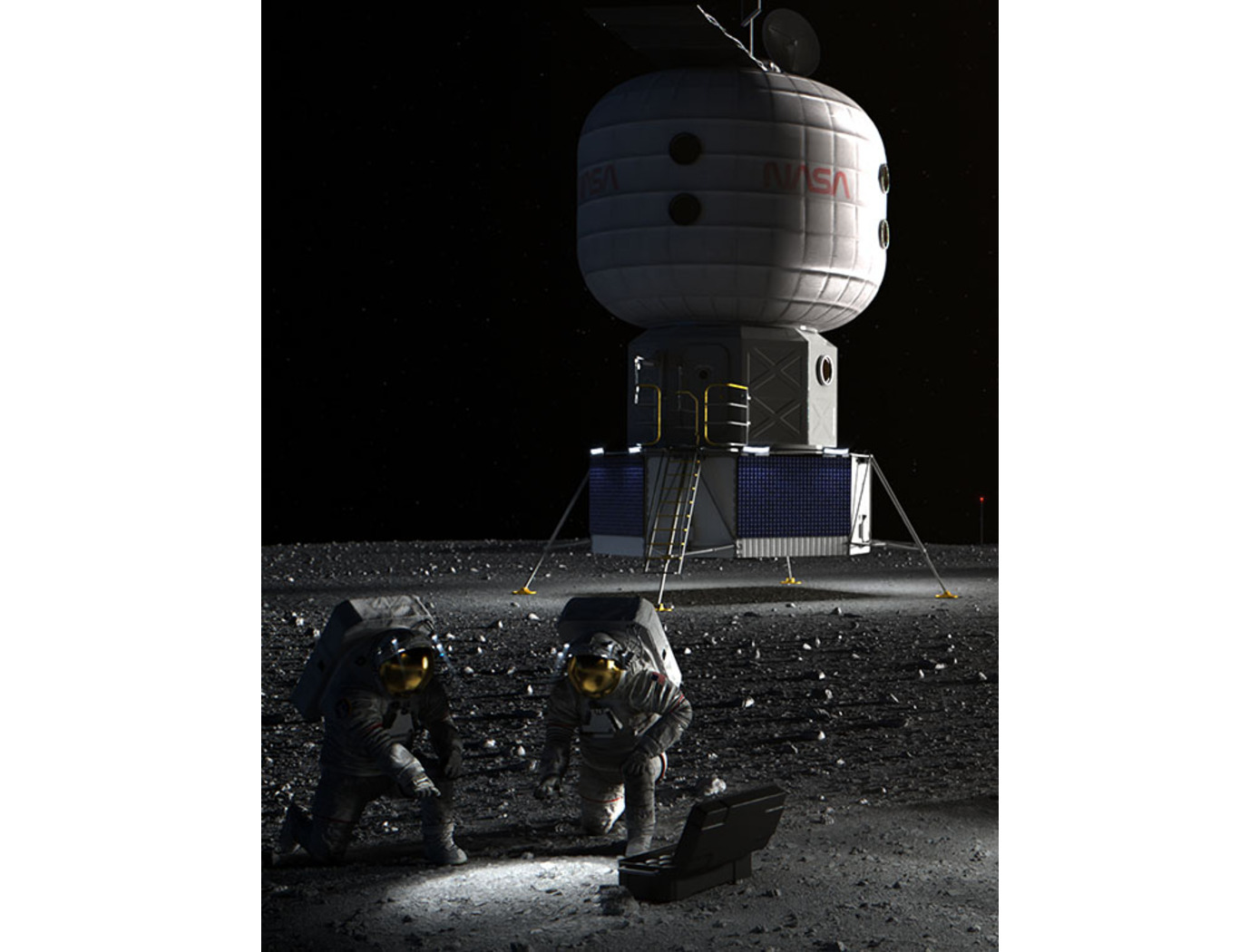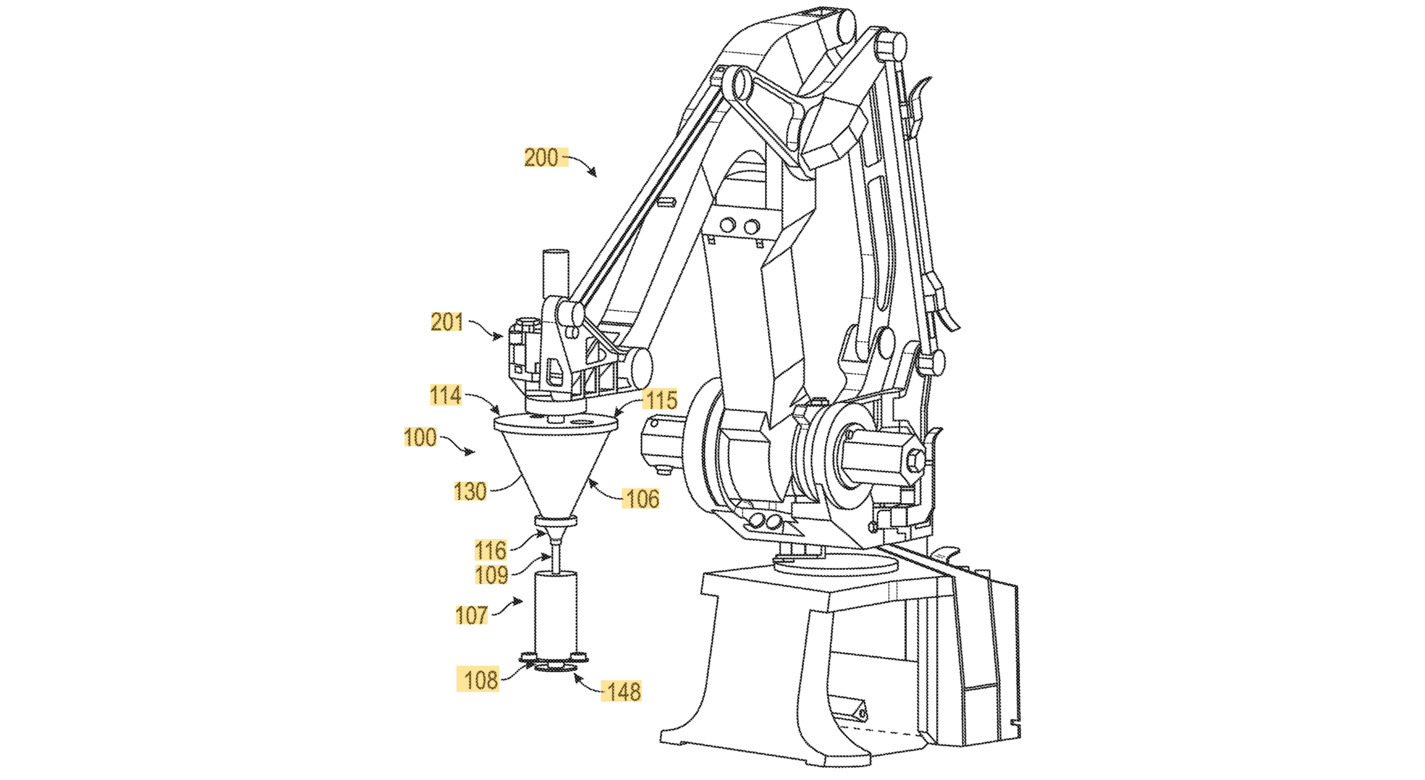Regolith-Polymer 3D Printing
manufacturing
Regolith-Polymer 3D Printing (KSC-TOPS-88)
Building infrastructure using available resources
Overview
The history of construction materials and methods has evolved over time, with Portland cement concrete being the most widely used material on Earth. Constructing habitats and infrastructure on the Moon and Mars, however, requires a different approach given the lack of such conventional construction resources and materials.
Recognizing the need for in-situ resource utilization (ISRU) to support long-duration human missions to the Moon and Mars, NASA's Kennedy Space Center and Sidus Space have developed a novel three-dimensional print head apparatus using regolith-polymer mixtures as a building material. The invention paves the way for enabling the construction of habitats and other critical infrastructure on the Moon and other planetary bodies using available resources. The Regolith-Polymer 3D Printing System can also be adapted to work with other crushed rock materials or mixtures depending on resource availability at construction sites.
The Technology
The invention consists of a 3D print head apparatus that heats and extrudes a regolith-polymer (or other) mixture as part of an additive manufacturing process. The technology includes a securing mechanism, hopper, nozzle, barrel, and heating system. The securing mechanism attaches to a wrist joint of a robotic arm. The hopper, connected to the securing mechanism, has a cavity and a lower aperture. The barrel is an elongated, hollow member with its first end connected to the hopper's lower aperture and its second end connected to the nozzle's upper aperture. The heating system is positioned along the barrel and comprises a heater, thermocouple, insulator, and heating controller. The heating controller activates the heater based on input signals received from the thermocouple.
The print head apparatus also includes a feed screw, drive shaft, and motor. The feed screw is positioned within the elongated hollow member of the barrel, and the drive shaft transmits torque to the feed screw. The motor provides torque to the drive shaft.
An agitator is secured to the drive shaft, facilitating the consistent movement and mixing of the regolith-polymer mixture in the hopper. The nozzle includes a tube with an open end and an occluded end, allowing the mixture to be extruded through the lower aperture.
The jointly developed 3D print head technology enables efficient, large-scale additive construction using in-situ resources, such as regolith or other materials. The innovation reduces the need for transporting materials from Earth and allows for sustainable habitat development on the Moon or Mars. Given its adaptability to different crushed rock-polymer materials, the invention may also serve as an alternative to conventional Portland concrete construction on Earth.


Benefits
- Facilitates in-situ resource utilization (ISRU): The invention was designed to utilize in-situ resources, reducing the need for transporting construction materials long distances (e.g., from Earth to the Moon). Additionally, less material is needed as advanced designs can use optimized hollow structures.
- Offers automation & precision: The invention is designed to work with a robotic arm, providing precise positioning and movement during the printing process.
- Provides versatility: This 3D printing system is compatible with various regolith (or crushed rock)-polymer mixtures, enabling adaptability to different environments.
- Enables complex geometries: The invention also makes it possible to print complex shapes that cannot be achieved using concrete from work, brick laying, or other traditional construction processes.
Applications
- Lunar habitat and infrastructure construction: Building habitats on the Moon (or other planetary bodies) using in-situ resources.
- 3D-printing of large structures: Creating large structures on Earth, the Moon, Mars, etc.
- Expand construction materials: Leverage available materials to build infrastructure on Earth and beyond.
|
Tags:
|
Similar Results

Recyclable Feedstocks for Additive Manufacturing
NASA's new technique for generating recyclable feedstocks for on-demand additive manufacturing employs the high-yield reversibility of the Diels-Alder reaction between maleimide and furan functionalities, utilizing the exceedingly favorable interaction between specific chemical functionalities, often termed "click reactions" due to their rapid rate and high efficiency. Integration of these moieties within a polymer coating on epoxy microparticle enables reversible assembly into macroscopic, free-standing articles. This click chemistry can be activated and reversed through the application of heat. Monomer species can be used to incorporate these functionalities into polyimide materials, which provide excellent mechanical, thermal, and electrical properties for space applications. Copoly (carbonate urethane) has been shown to be a viable coating material in the generation of polymer-coated epoxy microparticle systems and is amenable to being processed through a variety of approaches (e.g., filaments and slurries for 3D printing, compression molding, etc.). The polymeric materials are grown from the surfaces of in-house fabricated epoxy microparticles. The thermal and mechanical properties of the microparticles can be readily tuned by changes in composition.
There are a number of potential applications for this NASA technology ranging from use of these materials for recyclable/repurpose-able articles (structural, decorative, etc.) to simple children's toys. More demanding uses such as for replacement parts in complex industrial systems are also possible. For long term space missions, it is envisioned that these feedstocks would be integrated into secondary spacecraft structures such that no additional concerns would be introduced due to in-space chemical reactions and no additional mass would be required.

Polymer Composite Material
The Polymer Composite Material provides a method for using comingled plastics in a way that is not greatly impacted by changes in composition. Comingled plastics are used as a combination filler/binder material where low melting plastics are converted into binders with higher melting plastics serving as filler and structural reinforcements. The Polymer Composite Material is made by feeding the source materials into an extruder - a solid polymeric binder at a first feed rate and a solid filler at a second feed rate. The extruder (a) melts the solid polymeric binder, (b) mixes the melted solid polymeric binder with the solid filler, and (c) extrudes an extrudate of the solid polymeric binder and solid filler to form the composite material. The composite material has a binder to filler ratio determined by the first feed rate and second feed rate. The solid filler may be granular glass and the solid polymeric binder may be at least one of polypropylene, polyethylene, polyvinyl chloride, and polyethylene terephthalate. The material can be created in a range of densities using foaming techniques.

Fully Automated High-Throughput Additive Manufacturing
The technology is a method to increase automation of Additive Manufacturing (AM) through augmentation of the Fused Filament Fabrication (FFF) process. It can significantly increase the speed of 3D printing by automating the removal of printed components from the build platform without the need for additional hardware, which increases printing throughput. The method can also be leveraged to perform automated object testing and characterization. The method includes embedding into the manufacturing instructions methods to fabricate directly onto the build platform an actuator tool, such as a linear spring. The deposition head can be leveraged as a robotic manipulator of the actuator tool to bend, cock, and release the linear spring to strike the target manufactured object and move it off the build platform of the machine they were manufactured on. The ability for an object to 'fly off of the machine that made it' essentially enables automated clearing of the processed build volume. The technology can also be used for testing the AM machine or the feedstock material by successively fabricating prototypes of the manufactured object, and taking measurements from sensors as the actuator strikes the prototype. This provides automated testing for quality control, machine calibration, material origins, and counterfeit detection.

Improved Lunar Regolith Simulant Ion Implantation
Researchers and other technology developers require regolith simulants that accurately emulate the properties of lunar, Martian, and asteroid soils to ensure that the processes, devices, tools, and sensors being developed will be usable in an active mission environment. To move toward higher fidelity regolith simulants, NASA has developed a system that takes typical regolith simulants and implants ions of relevant elements to better simulate the conditions of extraterrestrial soils.
The ion implantation device developed here is composed of three key elements as shown in the figure below: two hopper and rotary valve elements and the acceleration grid structure. To perform the ion implantation, the system is first placed within a vacuum chamber, pumped down, and gases of the elements of interest are pumped into the chamber. The system then first passes a mass of granulated lunar regolith simulant through two stages of hoppers and rotary valves to condition the material. Key to the system is a process for interstitial gas removal (a source of contamination) as shown in the figure on the right. After conditioning, the regolith simulant is passed between two parallel electrodes under a high voltage, accelerating ions of the process gas and implanting those ions within the regolith simulant at controllable depths.
The related patent is now available to license. Please note that NASA does not manufacturer products itself for commercial sale.

Multifunctional Ablative Thermal Protection System
The initial compression pad design for Orion was complex and limited to Earth orbit return missions, such as the 2014 Exploration Flight Test-1 (EFT-1). The 2-D carbon phenolic material used for EFT-1 has relatively low interlaminar strength and requires a metallic sheer insert to handle structural loads. There are few options for materials that can meet the load demands of lunar return missions due to performance or part-size limitations. The 3DMAT material is a woven fiber preform fully densified with cyanate ester resin. It produces a large composite with significant structural capabilities and the ability to withstand high aerothermal heating environments on its outer surface while keeping the inner surface cool and protected from the aerothermal heating. The robustness of the 3DMAT material is derived from high fiber volume (>56%), 3-D-orthoganol architecture, and low porosity (0.5%). Orion has adopted 3DMAT for all future MPCV missions, including EM-1 schedule to launch in 2018.



